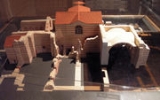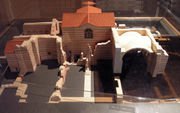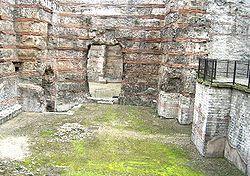
Thermes de Cluny
Encyclopedia

Paris
Paris is the capital and largest city in France, situated on the river Seine, in northern France, at the heart of the Île-de-France region...
' 5th arrondissement and which are partly subsumed into the Musée de Moyen Age-Hôtel de Cluny
Musée de Cluny
The Musée de Cluny , officially known as Musée National du Moyen Âge , is a museum in Paris, France...
.
The present bath ruins constitute about one-third of a massive bath complex that is believed to have been constructed around the beginning of the 3rd century. The best preserved room is the frigidarium
Frigidarium
A frigidarium is a large cold pool of Roman baths. It would be entered after the Caldarium and the Tepidarium, which were used to open the pores of the skin. The cold water would close the pores. There would be a small pool of cold water or sometimes a large Swimming pool...
with intact architectural elements such as Gallo-Roman vaults, ribs and consoles and fragments of original decorative wall painting and mosaics.

Lutetia
Lutetia was a town in pre-Roman and Roman Gaul. The Gallo-Roman city was a forerunner of the re-established Merovingian town that is the ancestor of present-day Paris...
, as evidenced by the fact that the consoles on which the barrel ribs rest are carved in the shape of ships' prows. Like all Roman Baths
Thermae
In ancient Rome, thermae and balnea were facilities for bathing...
, these baths were freely open to the public, and were meant to be, at least partially, a means of romanizing
Romanization
In linguistics, romanization or latinization is the representation of a written word or spoken speech with the Roman script, or a system for doing so, where the original word or language uses a different writing system . Methods of romanization include transliteration, for representing written...
the ancient Gauls
Gauls
The Gauls were a Celtic people living in Gaul, the region roughly corresponding to what is now France, Belgium, Switzerland and Northern Italy, from the Iron Age through the Roman period. They mostly spoke the Continental Celtic language called Gaulish....
. http://www.musee-moyenage.fr/homes/home_id20392_u1l2.htm As the baths lay across the Seine
Seine
The Seine is a -long river and an important commercial waterway within the Paris Basin in the north of France. It rises at Saint-Seine near Dijon in northeastern France in the Langres plateau, flowing through Paris and into the English Channel at Le Havre . It is navigable by ocean-going vessels...
river on the left bank
Rive Gauche
La Rive Gauche is the southern bank of the river Seine in Paris. Here the river flows roughly westward, cutting the city in two: looking downstream, the southern bank is to the left, and the northern bank is to the right....
and were unprotected by defensive fortifications, they were easy prey to roving barbarian groups who apparently destroyed the bath complex sometime at the end of the 3rd century.
The bath complex is now partly an archeological site and partly incorporated into the Musée du Moyen Age, and as such is the occasional repository for historic stonework or masonry found from time to time in Paris. The spectacular frigidarium is entirely incorporated within the museum and houses the Pilier des Nautes
Pillar of the Boatmen
The Pillar of the Boatmen is a square-section stone bas-relief with depictions of several deities, both Gaulish and Roman...
. Although somewhat obscured by renovations and reuse over the past two thousand years, several other rooms from the bath complex are also incorporated into the museum, notably the gymnasium which now forms part of gallery 9 (Galley of French Kings and sculptures from Notre Dame). The caldarium (hot water room) and the tepidarium (warm water room) are both still present as ruins outside the Musée itself and on the museum's grounds.
Sources
- Album de Musee' national du Moyen Age Thermes de Cluny, Pierre-Yves Le Pogam, Dany Sandron (ISBN 2-7118-2777-1)
- Architect’s Guide to Paris, Renzo Salvadori, (ISBN 0-408-50068-9) London, 1990.
- Caesar to Charlemagne: The beginning of France, Robert Latouche, (ISBN 0-460-07728-7) 1968.
- Round and about Paris, Vol. 1, Thirza Vallois (ISBN 0-9525378-0-X), 1995.

